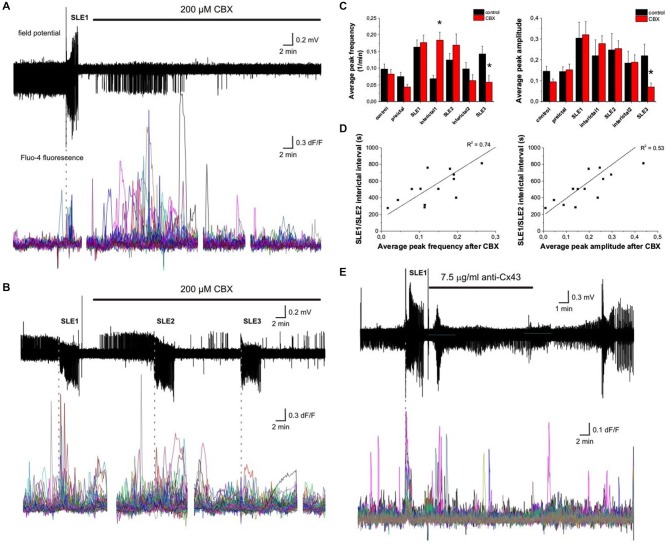Figure 5.
Anti-convulsant effect of gap junction blockade by gap junction inhibition. (A) (Top) Extracellular field potential recording of a seizure-like event (SLE) in the CA3 region in a hippocampal slice. 200 μM carbenoxolone (CBX) prevents the appearance of additional SLEs. (Bottom) Ca2+ transients measured by Fluo-4 fluorescence in CA3 astrocytes. Vertical dashed line indicates the start of SLE. (B) (Top) Extracellular field potential recording of SLEs in the CA3 region in a hippocampal slice. 200 μM CBX does not prevent the appearance of additional SLEs, but increases the interictal interval. (Bottom) Ca2+ transients measured by Fluo-4 fluorescence in CA3 astrocytes. Vertical dashed lines indicate the start of SLEs. (C) Average peak frequency (left) and peak amplitude (right) during the control period, the application of low-[Mg2+] ACSF (preictal) and the SLEs and interictal periods. Peak frequency is significantly increased in the first interictal period after the administration of 200 μM CBX. Asterisks denote significant differences between the control conditions and CBX application. (D) Relationships between Ca2+ peak frequency (left) or amplitude (right) and length of interictal intervals after the first SLE in N = 13 slices in which further SLEs appeared during CBX application. In N = 7 slices 200 μM CBX completely eliminated SLEs (average peak frequency = 0.23 ± 0.07 1/min; average peak amplitude = 0.32 ± 0.11 in these slices). (E) (Top) Extracellular field potential recording of a seizure-like event (SLE) in the CA3 region in a hippocampal slice. 7.5 μg/ml (1:100 dilution) Cx43 antibody prevents the appearance of additional SLEs. (Bottom) Ca2+ transients measured by Fluo-4 fluorescence in CA3 astrocytes. Vertical dashed line indicates the start of SLE.

